Indication-Specific Approach to Filler Injections-Juniper Publishers
Authored by Sabine Zenker
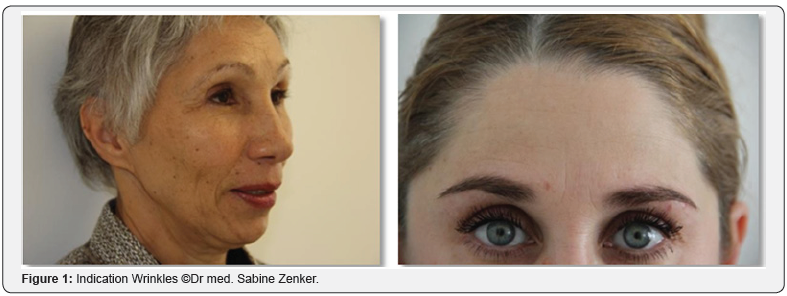
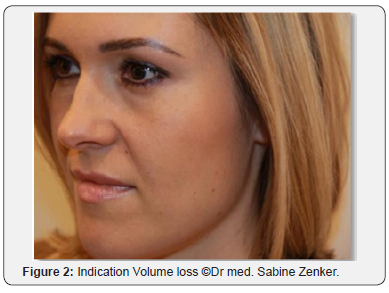
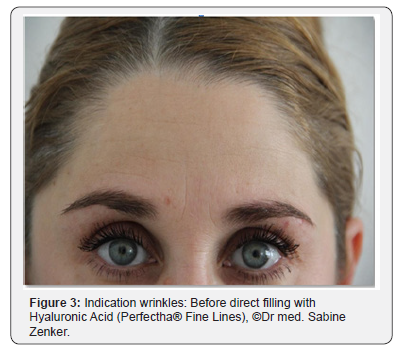
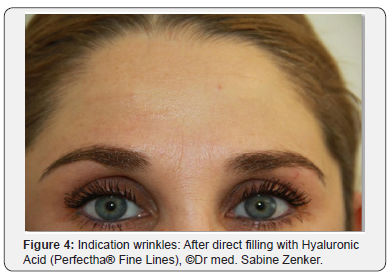
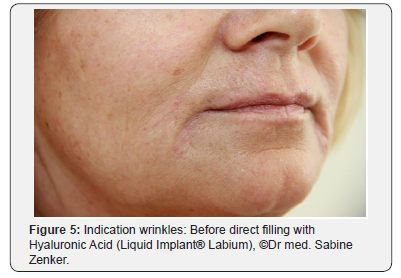
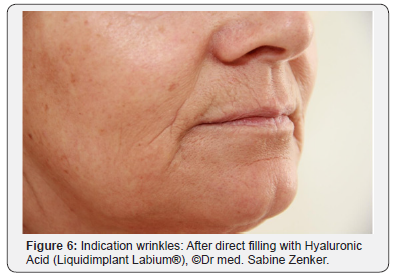
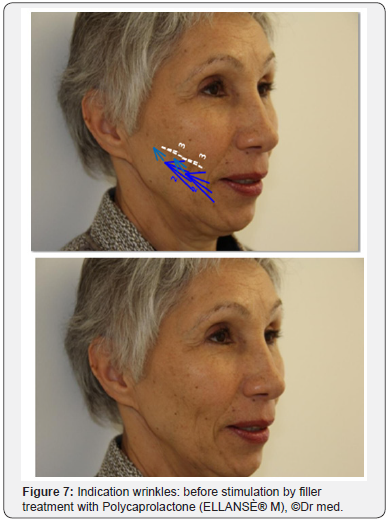


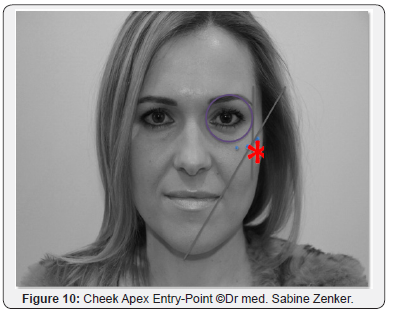
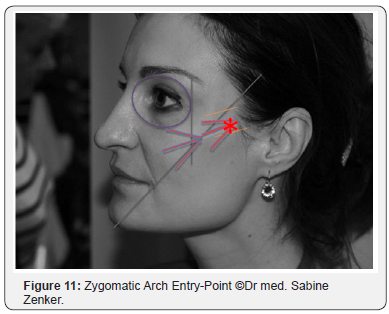
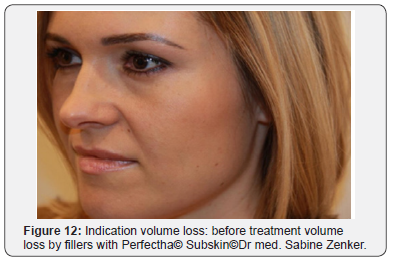


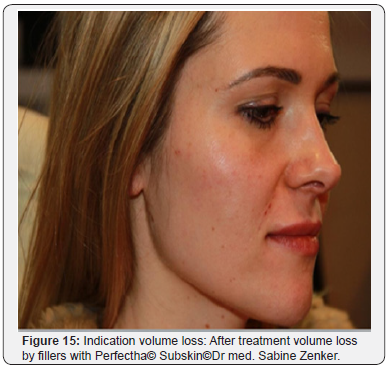
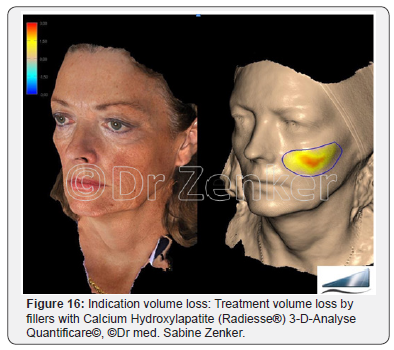
Summary
Facial aging is a complex process resulting in
appearance of wrinkles and folds as well as sagging and volume loss.
This article does outline a science-based, indication-specific
therapeutic concept for filler injections to the aging ace.
Keywords: Indication specific treatment; Filler; Fill; Ftimulate; Volumize
The Age-Related Three-Dimensional Facial Changes
Even though facial aging starts at the surface by
showing signs of skin aging, the changes go far beyond the skin: it
finally involves all other facial structures such as the muscles,
retaining ligaments, fat pads and the bony structures. Predominantly and
for a youthful and appealing look, the architecture and position of the
fat pads is pivotal. But over time, the facial fat pads get
redistributed, they do atrophy and get separated [1-6]. Further to this,
a remarkable bony resorption takes place and doesn`t give the needed
structural support [3,6,7]. All this results in deflation, volume loss
and sagging in a three-dimensional way [6,8].
Typical Indications for Filler Treatments
Here, very importantly, filler treatments come into
play. Any treatment in aesthetic dermatology does require an
indication-specific treatment approach, the individual diagnosis has to
be set up in order to decide for the respective treatment plan. Typical
indications for filler treatments are:
Wrinkles
Creases, wrinkles and folds are a typical sign of
skin aging and can give facial expressions an unwanted negative touch
(Figure 1).

Volume Loss
Further changes such as the appearance of shades,
furrows, volume loss and overall sagging are the next typical indication
for facial filler injections to restore facial proportions in order to
get back the pleasing facial features one had in the past or to improve
aspects such as shape, form and volume of a face; basically, it`s about
to give back a healthy look with natural fullness and soft and smooth
transitions (Figure 2).

Treatment Concept for Wrinkles by Filler Injections
Here, the concept of filling wrinkles [direct filling by hyaluronic
acid [HA]] and of dermal stimulation by polycaprolactone [PCL]
will be discussed.
For direct filling by hyaluronic acid, typical indications on
forehead- or perioral lines etc.. , the filler is injected intra-dermally
in a retrograde fashion [“blanching”] by serial-puncture- or
linear- threading, using a sharp needle [30G ½”] [9]. The author
does mix the respective hyaluronic acid with local anesthetics in
a ratio up to 30% [off-label-use!] to basically achieve an optimal
integration of the filler material in the superficial dermis. The
correction should never be done over the clinical endpoint. To
control filler placement, author often uses injection systems
as this increases the accuracy of filler placement and its dose
which reduces side effects such as pain and bruising to improve
the overall aesthetic outcome in especially such very superficial
injections [10]. The result of this direct filling technique with
hyaluronic acid lasts -depending on material used and individual
conditions- for some months (Figure 3-6).




The stimulation technique by filler using
polycaprolactone
[PCL] is especially suited if an immediate filling is desired.
Additionally, the effect of collagen stimulation starts appr. 3
months after injection. Polycaprolactone is a biodegradable filler
material consisting of microparticles of PCL suspended in a gel
carrier [carboxy-methyl-cellulose [CMC] with both, volumizing
and stimulating capacities [11,12]. This filler has to be placed
using a 25G 1½” blunt tipped cannula in a subscision-wise way:
PCL is fanned sub-dermally in a fan pattern to cover the whole area to
be treated in a retrograde fashion; the point of insertion
is chosen in a 90° angle and in the middle of each respective fold.
The approximate amount of filler to be injected is 0.1cc (Figure
7,8).


Treatment Concept for Volume Loss by Filler Injections
The treatment of the three-dimensional volume loss will be
showcased here by demonstrating techniques for the midface.
He tTypical indications here are the sunken-in frontal part of the
cheek and the sagged lateral part.
To plan the individual injection strategy, to identify to be
treated areas with its entry points as well as the danger zones,
facial mapping is pretty use- and helpful (Figure 9).

Here, typically highly visco-elastic hyaluronic acid fillers with
a good volumizing capacity [13,14], Calcium Hydroxylapatite,
CaHA [Radiesse©], a calcium particles based filler [15,16]
or Polycaprolactone [PCL] are used. The use of blunt tipped
cannulas results in a more atraumatic [15], quicker treatment
procedure, especially when the filler needs to be placed over
“longer distances” [16-22].
The following pictures illustrate typical entry points for
this treatment concept, the Cheek-Apex- Entry-Point and the
Zygomatic Entry-Point.
The Cheek Apex Entry-Point, entry-point to treat the sunkenin
frontal part of the chees, is the point around which the frontal
projection of the cheek will be reconstituted (Figure 10).


Sunken-in frontal part cheek
Starting point is the Cheek Apex Entry-Point. The filler is
injected in a bolus technique [„gunshot- wise“], in a retrograde
way and placed supraperiostally; according to the clinical needs,
more injections medial and eventually lateral of the first entrypoint
are performed in a “banana-wise” way. Amount of filler per
point is approximately 0.1cc. Augmentation is conducted up to
the clinical endpoint.
Sagged lateral part cheek
Starting point is the Zygomatic Arch Entry-Point. The filler
is injected in a fanning technique in retrograde fashion starting
supraperiostally and ending up subdermally on the most lateral
part of the to be injected area. Amount of filler per point is
approximately 0.1-0.2cc. Augmentation is conducted up to the
clinical endpoint.
Using these two techniques the frontal projection of the
cheeks as well as the lateral lifting can be effected in a customized
and individual way.
Here, the following illers are used: hyaluronic acid Perfectha©
Subskin and Calcium Hydroxylapatite [Radiesse©] [mixed with
Lidocain 1% in a 20% ratio]. As equipment, a blunt tip cannula
25G/38mm is used [Steriglide®] (Figure 12-16).





Summary
Age related facial changes such wrinkles, volume loss and
sagging can be easily and individually treated by filler. The
indication-specific filler treatment approach helps to identify the
respective indications. Thanks to the versatility of degradable
fillers, they can serve for all, filling, stimulating as well as
volumizing.
For more
details JOJ Dermatology & Cosmetics
(JOJDC) please
click on: https://juniperpublishers.com/jojdc/classification.php
To read more…FullText in Juniper Publishers click on https://juniperpublishers.com/jojdc/JOJDC.MS.ID.555554.php
Comments
Post a Comment